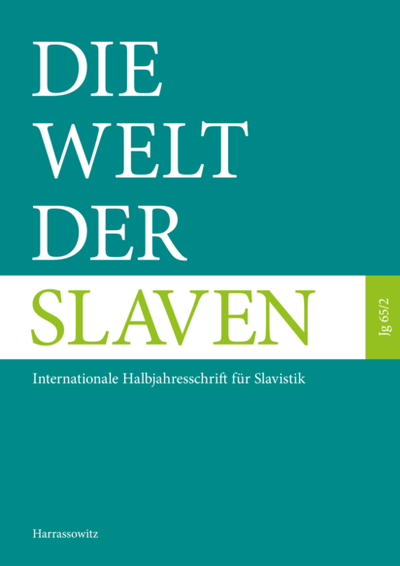Сказать-то сказал – Verben mit klitischem Demonstrativpronomen im Russischen
DOI:
https://doi.org/10.13173/WS.65.2.312Abstract
Skazat’-to skazal – Verbs with clitic demonstrative pronouns in Russian
Studies on the pragmatic value and information-structuring function of lexical compounds with the particle ‑to in Russian have shown that the semantics of the compound refers to information which is contextually available to the hearer, as an appeal to activate this information. The appellative function may also be used to introduce a new theme in discourse which is loosely connected with an already introduced discourse topic. So far, studies about ‑to compounds were nearly exclusively concerned with non-verbal elements, while our study refers to verbal compounds in the infinitive (obʺjasnjatʹ-to) or a finite form (govorim-to). Testing different collocations, the study confirms the finding of preceding studies that ‑to activates frame information which cannot be directly referred to by an immediately following anaphoric pronoun. Therefore, the imperfective aspect is predominant with the verbs used in a compound with ‑to. In contrast to single verbal compounds, the double constructions with “infinitive/finite verb + ‑to + finite verb” (čitatʹ-to čitali, skazal-to skazal) refer to a finite state of affairs which can be referred to in an immediately following utterance. Pointing to semantic differences between the single and the double verbal compounds with ‑to, it seems that double verbal compounds in colloquial Russian act like periphrases for the lacuna in the aspect system – reference to present tense finite actions. The paper is no full-fledged analysis of the phenomenon but wants to draw attention to the interesting construction.
Literaturhinweise
Abbott, Barbara. 2006. Definite and indefinite. In Brown, Keith (ed.), Encyclopedia of Language and Linguistics (2nd edn.), 392–399. Amsterdam.
Bolden, Galina B. 2008. Reopening Russian conversations: The discourse particle to and the negotiation of interpersonal accountability in closings. Human Communication Research 34. 99–136.
Bondarko, Aleksandr V. 1990. O značenijach vidov russkogo glagola. Voprosy jazykoznanija 4. 5-24.
Bonnot, Christine. 1990. La particule -to et la polémique cachée en russe moderne: À propos du statut énonciatif du thème. Revue des Études Slaves 65(1/2). 67–75.
Bonnot, Christine. 1991. La particule de thématisation -to en russe moderne. Revue des Études Slaves 63(4). 853–861.
Bonnot, Christine. 2015. Deixis, intersubjectivité et thématisation: La particule énonciative ‑to en russe contemporain. Faits de langues 45(1). 11–33.
Daiber, Thomas. 2008. Produktive Dativkonstruktionen: Possessive, deontische und temporale Attribution. In Kempgen, Sebastian & Gutschmidt, Karl & Jekutsch, Ulrike & Udolph, Ludger (ed.), Deutsche Beiträge zum 14. Internationalen Slavistenkongress, Ohrid 2008, 103–116. München.
Daiber, Thomas. 2009. Metaphorical use of the Russian imperative. Russian Linguistics 33(1). 11–35.
Dalʹ, Vladimir I. 1978–1980. Tolkovyj slovarʹ živogo velikorusskogo jazyka. 4 Bde. (Nachdruck der 2. Aufl. 1880–1882.) Moskva.
Diewald, Gabriele. 2011. Pragmaticalization (defined) as grammaticalization of discourse functions. Linguistics 49(2). 365–390.
Dobrovolʹskij, Dmitrij O. & Pöppel, Ljudmila. 2016. Konstrukcii to-to i N, v tom-to i N, v tom-to i vesʹ N: Korpusnoe issledovanie. Vestnik Novosibirskogo gosudarstvennogo pedagogičeskogo universiteta [NGPU] 2, 30, 61–72.
Franks, Steven. 2010. Clitics in Slavic. glossos 10 [157 Seiten]. https://slaviccenters.duke.edu/sites/slaviccenters.duke.edu/files/media_items_files/10franks.original.pdf.
Galinskaja, Elena A. (2017): Ukazatelʹnoe mestoimenie tot-to v kurskich govorach. Trudy Instituta russkogo jazyka im. V. V. Vinogradova 12. 73–87.
Gusev, Valentin Ju. 2005. Tipologija specializirovannych glagolʹnych form imperativa. (Diss. phil.) Moskva: Institut Jazykoznanija RAN.
Janda, Laura A. 2007. What makes Russian bi-aspectual verbs special? In Divjak, Dagmar & Kochańska, Agata (eds.), Cognitive paths into the Slavic domain, 83–109. Berlin.
Krasnov, Petr N. [1937.] Vom Zarenadler zur roten Fahne: Roman. Berlin.
Maslov, Jurij S. 2004. Izbrannye trudy: Aspektologija, Obščee jazykoznanie (Klassiki otečestvennoj filologii). Moskva.
McCoy, Svetlana. 2001. Connecting information and discourse structure levels through “Kontrast”: Evidence from colloquial Russian particles -to, že, and vedʹ. In Kruijff-Korbayová, Ivana & Steedman, Mark (eds.), Proceedings of the ESSLLI 2001 Workshop on Information Structure, Discourse Structure and Discourse Semantics, 85–98. Helsinki.
McCoy, Svetlana. 2002. Semantic and discourse properties of colloquial Russian construction of the form “X-to X, a …”. glossos 3 [26 Seiten]. https://slaviccenters.duke.edu/sites/slaviccenters.duke.edu/files/media_items_files/3mccoy.original.pdf.
NKRJa = Nacionalʹnyj korpus russkogo jazyka. http://ruscorpora.ru/.
Rathmayr, Renate. 1985. Die russischen Partikeln als Pragmalexeme. München.
Späth, Andreas. 2006. Determinierung unter Defektivität des Determinierersystems: Informationsstrukturelle und aspektuelle Voraussetzungen der Nominalreferenz slawischer Sprachen im Vergleich zum Deutschen. Berlin.
Thurmair, Maria & Oppenrieder, Wilhelm. 1989. Kategorie und Funktion einer Partikel. Oder: Was ist eigentlich ‘eigentlich’ EIGENTLICH? Eine Replik auf M. Kohrt. Deutsche Sprache 17. 26–39.
Tolstoj, Lev N. 1911. Krieg und Frieden (Gesammelte Werke, ed. Raphael Löwenfeld, Serie 1, Bd. 11–14). 4 Bände. 3 Aufl. Jena.
Uryson, Elena V. 2019. Leksičeskoe značenie glagola v vidovoj pare: Semantičeskaja teorija i kriterij Maslova. Voprosy jazykoznanija 3. 45–70.
Užankov, Aleksandr N. (ed.). 1991. Russkaja bytovaja povestʹ XV–XVII vv. Moskva.
Zaliznjak, Andrej A. 2008. Drevnerusskie ėnklitiki. Moskva.
Zybatow, Lew. 1990. Was die Partikeln bedeuten: Eine kontrastive Analyse Russisch-Deutsch. München.

